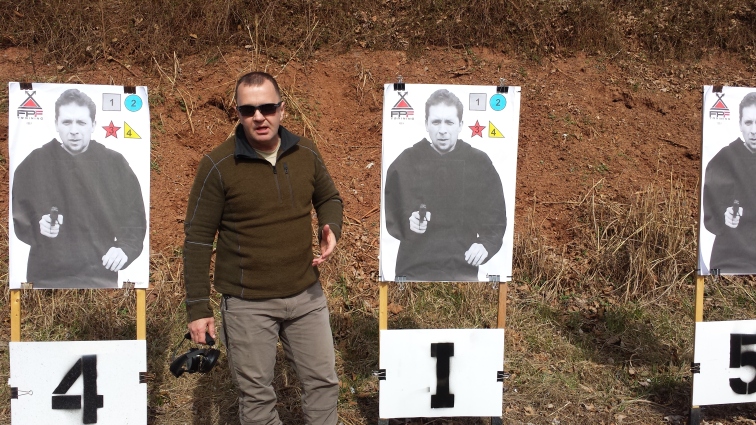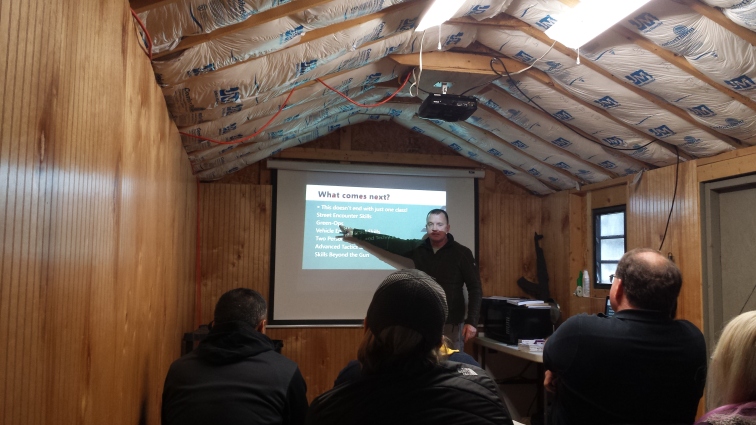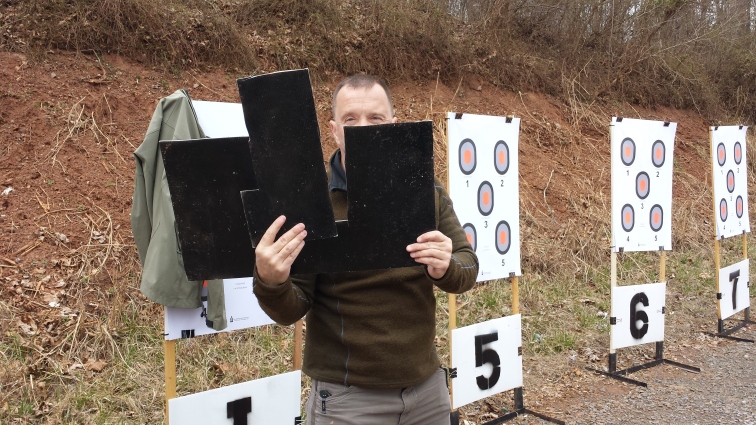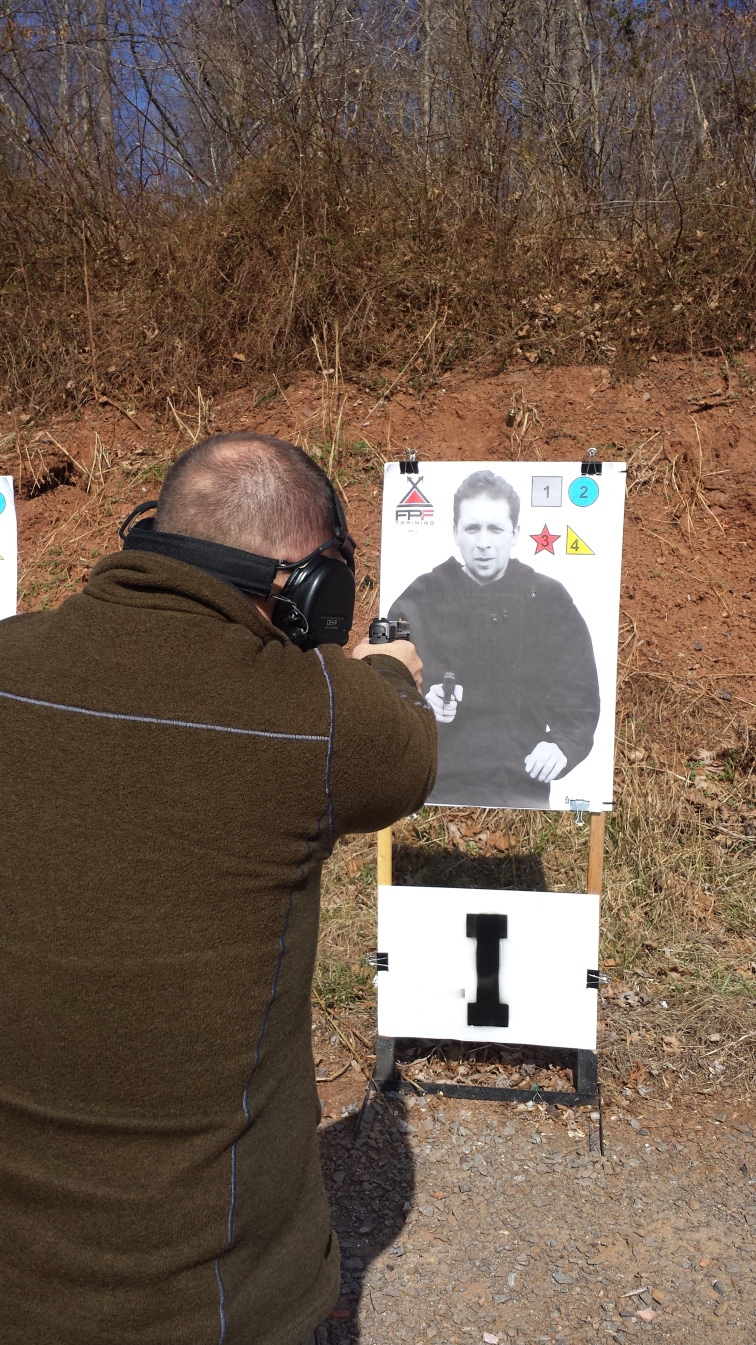I continue to view John Murphy of FPF Training as something of a hidden gem in the training industry. My experience in courses I have taken with him to date is that he provides realistic, research-based training. Accordingly, I remain drawn to the menagerie of courses he offers.

As it happened, though my plan is, at some point, to take ALL of the classes Murphy offers, I was not planning to take this class this particular weekend. However, Murphy contacted me and asked if I would like to take the class, as he did not anticipate it filling anyway. I had to do some creative scheduling with the family, but I was able to make it. I must say yet again that I love that Murphy offers so many single-day courses, as it affords people like myself the ability to still have half a weekend with the family. The course typically runs $175, and though my tuition was waived by Murphy, the cost of the course is a bargain considering all that is included.
The class itself is marketed as (my words) the next class you should take after taking a state-mandated concealed carry class.
The Training Day
The class was made up of 8 students including me. Two of the students were women: one a housewife, the other a nurse. The men came from a variety of backgrounds as well, including ex-military, teacher (me), retired, aerospace engineers, etc.
The weather was quite cold, probably upper 30s, until well into the afternoon when the sun finally appeared, at which point it peaked around 1400 hours in the upper 40s.

Equipment
I brought along both of my Glock 19s, switching out the black one I typically carry for the OD one that I now use more for training and practice. My OD one has had two recent changes made to it. I replaced the sights a couple of months ago with a set of Warren Tactical Sevigny night sights, with the front sight painted orange following the technique I showed in this article. These sights utilize the same dot-the-i sight picture I am used to with the Ameriglo I Dot Pros on my other Glocks, but offer a narrower rear notch and narrower front sight. At this point, I am not sure I will make the switch across the board, as I am not seeing the significant accuracy gains I had hoped to see. The other recent change I made was reverting back to a factory Glock slide-stop lever, as I was finding in practice sessions my recently modified grip was interfering with the Vickers Slide Stop lever.
I mostly used Blazer Aluminum 115 grain FMJ ammunition, switching to Wolf Steel 115 grain near the end of class. Perhaps oddly, my Glocks seem to shoot the aluminum ammunition more reliably than brass.
I used my Raven Concealment Systems Eidolon holster worn in my typical appendix position. This and my no-name double magazine carrier were mounted on my Megingjörð Belt from V Development Group. I used a combination of Glock factory and Magpul magazines.
Among the other students were several other Glocks (all in 9mm, including at least one other 19, a 26, a 43, and a 35 converted to 9mm), one 1911, and one Sig P22something in 9mm.
Classroom
After meeting at the designated rally point and caravanning a few miles to Murphy’s range, we assembled in the classroom at about 0815. The idea was for Murphy to present the bulk of his “lecture” material in the warm confines of the classroom, allowing us to move outside to the range once the weather warmed up a bit.
Murphy consistently runs well-organized classes that would make all of the professors in my graduate-level “teaching secondary education” classes proud. This class was no exception; indeed, it may have been even better organized than the other classes I have thus far taken with him. The class began with some administrative tasks, and then Murphy fired up the PowerPoint and delivered.

Murphy began by asking us why we were present for this class. Each student had to provide some sort of answer. Though Murphy told the class that I was there at his request, the fact is that I could have said no, that I was too busy, or that it was “spring forward” weekend and knew I would be tired, etc. So I added to his own answer for me with the truth: I was there to continue my journey.
We next went on to go over what the course was about. As always, Murphy had some videos ready to help instill mindset in the students, as we got to see a convenience store robbery attempt thwarted by an armed employee. Murphy also explained what this course would NOT be about, which was important to point out.
I am not going to share every little tidbit from the lecture, but a few high points for me:
1. The Murphy philosophy that shooting is a relatively easy-to-acquire skill, but that it is but one component of a much broader spectrum of self-defense;
2. That the pistol only comes out when NOT taking it out would be worse;
3. That we need to program our minds for a response rather than a reaction;
4. That all of this entails a true “lifestyle” choice.
The lecture was broken into separate segments that covered topics from the above broad spectrum:
1. Firearms Ownership Skills
2. Carry Skills and Knowledge
3. Post-incident Skills
4. Safety
5. Living With Firearms
6. Hardware (handguns, holsters, belts, ammunition, auxiliary items)
7. The Law
8. Dealing with Law Enforcement
9. General Do’s and Don’t’s
The lecture and discussion took several hours and included a few short breaks to utilize the restroom, eat snacks, etc.
The Range
We moved out to the range around 1130 and did some handgun manipulations dry using some dummy rounds provided by Murphy. We practiced loading, unloading, and reloading, and Murphy reviewed all of the fundamentals of marksmanship, one at a time, demonstrating along the way. We then got everything ready to go live and broke for about 30 minutes for lunch. Lunch was a bit of a working lunch, as Murphy used the opportunity to show us more real videos illustrative of points he had made during the earlier lecture.

After lunch, we finally got to go live on the range. We began with some simple marksmanship exercises at close range (3-7 yards), shooting one at a time under individual supervision so that Murphy could assess our skill levels.
I am not going to go into great detail discussing every drill we shot. As it happens, most of what we did were variations on a theme. We would vary our “starting positions” from arms at our sides, arms crossed, hands up and out in a “fence” position, etc., for each drill fired. For example, starting with hands at our sides, we might draw and shoot one round. Then we would switch to arms crossed and do the same, then the next position, etc. Then we might back up to 5 yards and shoot those same drills again, and yet again at 7 yards.
Overall, we only shot from the 3, 5, and 7 yards lines, the distances statistics indicate would be most likely in a defensive encounter. The drills we shot varied from “singles”, to “controlled pairs”, to “hearts and minds”, and so on.
Along the way, Murphy shot all the drills he asked us to shoot and also shot some other demos, such as what a hit really is (a hit to the ear lobe is technically a shot to the head, but we cannot count on it to do much to an adversary), what an acceptable sight picture/sight movie is at different distances, etc. During each drill he would help students out with any issues encountered, from malfunctions to recoil anticipation to gear issues.

One highlight of his teaching was when one student was suffering from what I would call significant recoil anticipation issues. Murphy used a teaching technique I had never seen anyone utilize before in all of the classes I have taken. It worked, and although the problem for the student did not completely evaporate, the look on the face of the student when she realized that she had it in her to be successful was priceless. Proof is in the pudding as her last target of the day looked significantly better than her first.
Another highlight of the class and a relatively new addition was a trauma medicine component. We watched a slide-show outlining tourniquets and their use. This presentation also covered pressure dressings, chest seals, and hemostatic gauze. Pros and cons of some different versions of each of these items was also discussed. Murphy also demonstrated how to apply a tourniquet (he had CAT, SOFT-W, and SWAT tourniquets on hand), and then we got to pair up and apply tourniquets and pressure dressings to each other. I would count this entire segment as pure “value-added”.

Near the end of class, Murphy did something he also did when I took his Street Encounters class. He had us grab a full magazine (or three), step up to the five yard line, and then just work on something on our own. I really like these “end on a high note” ideas. I chose to shoot some zipper drills (shooting the chest and then working my way up to the face), some strong-hand only and support-hand only shots, and some relatively rapid two-handed strings.
After our feel-good session, we engaged in some team-building exercises, gathered for the awarding of certificates, and went on our merry ways. I was leaving the range by about 1730 hours.
I fired a total of 196 rounds over the course of the day. I experienced no malfunctions of any kind
Final Thoughts
Murphy said that the idea behind this class is to show the students that there is an entire spectrum of knowledge and skills that fall under the broad heading of self-defense. Looked at another way, a state-mandated concealed-carry class only shows the tip of the iceberg, but with a course like this, the idea is to reveal the much larger portion of that iceberg that lies beneath the ocean’s surface. I thought that he met the overall goals for the class, as students left with handgun manipulation, safety, and marksmanship skills, trauma medicine practice/knowledge, the legal ramifications of the use of force, and the many other topics discussed in this review. In short, this was the type of class that I wish I had taken as perhaps my second self-defense course.
As always, thanks for reading. If you have any questions or comments, please post them below or on our Facebook page, as we always welcome CIVIL discourse. Be advised, however: comments that lack any constructive aspects will either not be approved at all or be deleted post-haste. I write reviews of the classes I take as much for my own future reference as for the general public. Please respect the coursework and save the drama for some other venue. Thanks!

Another great review! I am a big fan of FPF and John Murphy. My wife took her first formal class from John Murphy and afterwards insisted we take his next level course.
LikeLiked by 1 person
Michael,
Thanks for the feedback on the review. There was so much more I could have covered, content-wise, as Murphy definitely squeezed a lot of information into the 8 or so hours of the class. Good stuff.
–Robert
LikeLike
That Murphy guy, he’s alright in my book. I’ve enjoyed his classes at the TacCon, and enjoyed our banter even more.
LikeLiked by 1 person
I recently took my first class from John Murphy, and am planning on taking more.
LikeLike
Brad,
I’ve now taken four with Murphy, and John has now taken one as well. AARs are all here on the blog, so we hope you take the time to read through them. Take classes with him sooner rather than later so you can shout out to the world that you trained with Murphy back when…..
Thanks for the comment!
–Robert
LikeLike